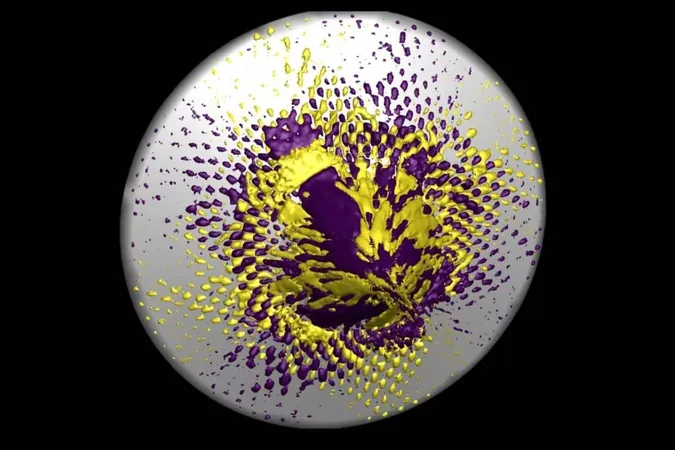
Breakthrough Study Reveals New Insights into Chronic Hand Eczema Through Innovative Tape Stripping Method
2025-01-10
Author: John Tan
Breakthrough Study Reveals New Insights into Chronic Hand Eczema Through Innovative Tape Stripping Method
In a groundbreaking study, researchers have unveiled that using tape stripping in conjunction with RNA sequencing can unveil critical molecular and immune characteristics of chronic hand eczema (CHE) lesions. This innovative approach holds the promise of enhancing our understanding of CHE's underlying mechanisms and paving the way for targeted therapies.
Authored by Jonathan Bar, MD, from the Icahn School of Medicine at Mount Sinai, the team's findings contribute to a much-needed expansion in the understanding of chronic hand eczema, particularly through the largest transcriptomic analysis conducted yet. Prior research on tape strip data from CHE patients has been limited, making this study a pivotal resource for further exploration in this field.
How the Study Was Conducted
The research involved an extensive analysis of 66 individuals with untreated moderate-to-severe CHE and a comparative group of 20 healthy controls, all recruited from various medical centers across the United States and Canada. Participants, aged between 18 and 75 years, were carefully selected based on stringent inclusion criteria, ensuring that they had a Physician Global Assessment (PGA) score of 3 or 4, indicative of their CHE severity lasting a minimum of six months.
Crucially, patients were excluded from the study if they were pregnant, had a body mass index above 35 kg/m², were experiencing active skin infections, or had suffered recent atopic dermatitis flare-ups. Furthermore, individuals receiving certain systemic treatments or topical agents were also disqualified, allowing for a more accurate analysis of the subjects' condition.
Key Findings and Implications
The results revealed that CHE lesions exhibited a common inflammatory profile, characterized by elevated levels of both type-1 and type-2 inflammatory mediators. Notably, upregulated markers included IL12RB2 and GATA3, suggesting a dual inflammatory response in the tissue. Meanwhile, essential epidermal barrier markers like loricrin and filaggrin were notably downregulated, highlighting the compromised skin barrier commonly seen in eczema patients.
A particularly striking discovery was the differing immune responses between participants. Those with CHE without a history of atopic dermatitis displayed a stronger type-1 immune response, whereas individuals also suffering from atopic dermatitis showed a more pronounced type-2 inflammatory pattern. This differentiation is crucial as it could lead to personalized treatment strategies based on the patient’s unique immunological profile.
Moreover, significant correlations were found between certain gene expression biomarkers and clinical severity indicators, such as the Hand Eczema Severity Index (HECSI). These insights not only deepen our understanding of CHE but also hint at potential new drug targets for the management of this chronic condition.
Conclusion: Turning the Tide on Chronic Hand Eczema
In conclusion, this study represents a major step forward in the field of dermatology, revealing complex molecular patterns of CHE and differentiating its expression between patients with and without atopic dermatitis. The researchers believe these findings could lead to novel therapeutic approaches and improved patient outcomes. As dermatologists and researchers digest these insights, the hope of finally conquering chronic hand eczema draws nearer.
Stay tuned for further updates on this evolving story, as the implications from these findings could reshape treatment protocols and enhance the quality of life for countless patients worldwide.



 Brasil (PT)
Brasil (PT)
 Canada (EN)
Canada (EN)
 Chile (ES)
Chile (ES)
 Česko (CS)
Česko (CS)
 대한민국 (KO)
대한민국 (KO)
 España (ES)
España (ES)
 France (FR)
France (FR)
 Hong Kong (EN)
Hong Kong (EN)
 Italia (IT)
Italia (IT)
 日本 (JA)
日本 (JA)
 Magyarország (HU)
Magyarország (HU)
 Norge (NO)
Norge (NO)
 Polska (PL)
Polska (PL)
 Schweiz (DE)
Schweiz (DE)
 Singapore (EN)
Singapore (EN)
 Sverige (SV)
Sverige (SV)
 Suomi (FI)
Suomi (FI)
 Türkiye (TR)
Türkiye (TR)
 الإمارات العربية المتحدة (AR)
الإمارات العربية المتحدة (AR)